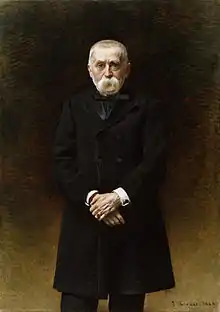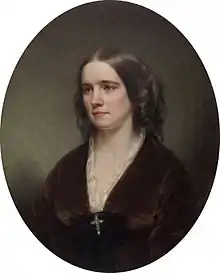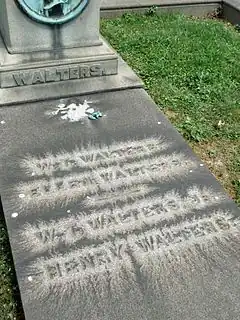William Thompson Walters
William Thompson Walters (May 23, 1820 – November 22, 1894)[1] was an American businessman and art collector, whose collection formed the basis of the Walters Art Museum.
William Thompson Walters | |
|---|---|
 Walters in 1883 by French artist Léon Bonnat | |
| Born | May 23, 1820 Liverpool, Pennsylvania, U.S. |
| Died | November 22, 1894 (aged 74) |
| Resting place | Green Mount Cemetery in Baltimore |
| Nationality | American |
| Education | University of Pennsylvania |
| Occupation | Merchant |
| Known for | Founding the Atlantic Coast Line Railroad Amassing an enormous art collection forming the basis of Walters Art Museum |
| Spouse |
Ellen Harper
(m. 1846; died 1862) |
| Children | Henry Walters Jennie Walters Delano |
| Signature | |
Early life and education
Walters was born on the Juniata River in Liverpool, Pennsylvania on May 23, 1820.[2] He was the son of the Scotch-Irish banker Henry Walters.[3]
Walters studied civil engineering at the University of Pennsylvania.[3]
Career
While educated as a civil engineer, he became interested in the coal and iron industry. While directing a smelting establishment in Lycoming County, Pennsylvania, Walters produced the first iron manufactured from mineral coal in the United States.[4]
In 1841, he moved to Baltimore, where he worked as a grain merchant and, in 1847, became a liquor wholesaler by establishing the importing firm of William T. Walters & Co.[4]
He spent much of the American Civil War in Europe, where he studied and purchased art. After the end of the war, he returned to the United States, where he invested in banking and railroads, founding the Atlantic Coast Line.[4] He was appointed as the United States commissioner at the Paris expositions of 1867 and 1878, and also to that at Vienna in 1873.[4] In the late 1880s, he took in business in the horse trade, importing Percheron horses with his partner Samuel Hopkins.[5]
With his success in business secured, Walters turned to art collection, purchasing contemporary American and European works. During the American Civil War, he took his wife to Europe and lived in Paris. (Their children were in boarding school in the US part of the time.) They traveled widely in Europe, where Walters cultivated his interest in art, and purchased numerous additions for his collection.[4]
In addition to contemporary European work, Walters began to collect Asian art and ceramics. His private collection became one of the largest and most valuable in the United States.[4]
From 1874 onwards, Walters opened his house in Mount Vernon Place to the public most springs, with a 50 cent entrance fee; all proceeds went to charity. This annual exhibit of his gallery netted $30,000 for the poor of Baltimore.[4]
Brayton Ives, a New York financier, made a well known collection of rare and historical swords. When he ceased collecting, the historical swords were sold, and through the efforts of Mr. Heber R. Bishop, William Thompson Walters and the American Art Association, the valuable sword collection, valued at $15,000, was donated to the Metropolitan Museum of Art.[6]
At his death in 1894, Walters had bequeathed his estate, estimated at $10,000,000, to his children.[7] His collection was left to his son Henry Walters, who had also been collecting art.[8] He added to it greatly, and founded the Walters Gallery (now the Walters Art Museum) in Baltimore at Mount Vernon Square. He donated this to the city of Baltimore at his death in 1931 for the benefit of the public.[9]
Personal life


In 1846, Walters married Ellen Harper (1822–1862), daughter of a prosperous Philadelphia merchant and his wife. Together, they were the parents of two children that survived to adulthood, a son and daughter:
- Henry Walters (1848–1931), who married Sarah Wharton Green (1859–1943), the widow of Pembroke Jones, in 1922.[10]
- Jennie Walters (1853–1922),[11] who married Warren Delano (1852–1920), a son of Warren Delano Jr. and a brother of Frederic Adrian Delano and Sara Ann Delano Roosevelt, in 1876.[12]
Ellen died young of pneumonia, contracted when they were traveling in England, in 1862. Walters lived another thirty-two years until his death on November 22, 1894 at his home, Mount Vernon Place in Baltimore.[1] He was buried at Green Mount Cemetery, also in Baltimore.[13]
 Bust by Rinehart of Walters' wife Ellen (Harper) Walters
Bust by Rinehart of Walters' wife Ellen (Harper) Walters Bust by Rinehart of Jennie Walters, their daughter
Bust by Rinehart of Jennie Walters, their daughter Portrait by Rajon of Henry Walters, their son
Portrait by Rajon of Henry Walters, their son Persecution of Christians in the Roman Empire, using the Barbary lion and tiger (likely Panthera tigris virgata).[14][15] Painting by Jean-Léon Gérôme, commissioned by Walters in 1863.
Persecution of Christians in the Roman Empire, using the Barbary lion and tiger (likely Panthera tigris virgata).[14][15] Painting by Jean-Léon Gérôme, commissioned by Walters in 1863.
Works
Among his writings are:
- Barye (1885)
- Notes Upon Certain Masters of the 19th Century (1886)
References
- "AMERICA'S GREAT ART COLLECTOR William Thompson Walters, Known Everywhere for His Devotion to Art, Dies in Baltimore" (PDF). The New York Times. November 23, 1894. Retrieved February 26, 2019.
- Kunz, George Frederick (1908). Industrial Art: How it is Advanced by Art Education : an Address. New York State Education Department. p. 121. Retrieved February 26, 2019.
- Hall, Henry (1896). America's Successful Men of Affairs: The United States at large. New York Tribune. p. 822. Retrieved February 26, 2019.
- This article incorporates text from a publication now in the public domain: Rines, George Edwin, ed. (1920). . Encyclopedia Americana.
- James A Clark Jr. Jim Clark Soldier Farmer Legislator. p. 90.
- Kunz, George F. "Heber Reginald Bishop and his Jade Collection. American Anthropologist. New Series, Volume #5, January–March 1903. Page 116.
- "THE WALTERS ART COLLECTION It Is Left to the Testator's Two Children, and Is Likely to Remain Intact Under the Will" (PDF). The New York Times. December 4, 1894. Retrieved February 26, 2019.
- "WALTERS ART TREASURES Remarkable Judgment Displayed in Their Collection. THEIR HISTORIES ARE INTERESTING Pathetic Story of the Bonvin Aqua- relles — Jerome's Careful Work — Swords Representing the Souls of Knights" (PDF). The New York Times. November 26, 1894. Retrieved February 26, 2019.
- William R. Johnston, William and Henry Walters: The Reticent Collectors (Johns Hopkins University Press, 1999).
- "HENRY WALTERS IN SURPRISE MARRIAGE Baltimore Financier, 73, Weds Mrs. Pembroke Jones, Widow of His Old Friend. THEY SAIL ON AQUITANIA Noted Art Collector and Bride Tell on Steamer of Their Wedding a Few Hours Before" (PDF). The New York Times. April 12, 1922. Retrieved February 26, 2019.
- "DEATH MAY CLEAR UP MYSTERY OF A LIGHT Burning in Mansion 32 Years Since Daughter Married Against Walters's Will" (PDF). The New York Times. December 4, 1922. Retrieved February 26, 2019.
- "WARREN DELANO KILLED BY TRAIN AT BARRYTOWN His Favorite Horse, Frightened by Express, Dashed On Track, Carrying Him to Death. BORNE 150 FEET BY ENGINE Uncle of Franklin D. Roosevelt and Had Large Coal interests in Pennsylvania. OWNED STABLE OF HORSES He Intended to Exhibit Animal HeWas Driving at Dutchess County Fair Tomorrow" (PDF). The New York Times. September 10, 1920. Retrieved February 26, 2019.
- "MR. WALTERS LAID AT REST Buried in Greenmount Cemetery — Friends From Many Parts of the Country Present at the Services" (PDF). The New York Times. November 25, 1894. Retrieved February 26, 2019.
- Nowell, Kristin; Jackson, Peter (1996). Wild Cats: Status Survey and Conservation Action Plan (PDF). Gland, Switzerland: IUCN/SSC Cat Specialist Group. pp. 1–334. ISBN 2-8317-0045-0.
- Millar, Fergus (2006) A Greek Roman Empire: Power and Belief under Theodosius II (408–450). University of California Press. p. 279. ISBN 0520941411.